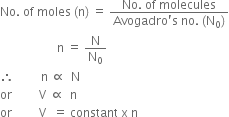 Short Answer Type
Short Answer Type Long Answer Type
Long Answer TypeA gas cylinder containing cooking gas can withstand a pressure of 14.9 bar. The pressure gauge of the cylinder indicates 12 bar at 27°C. Due to sudden fire in the building, the temperature starts rising. At what temperature will the cylinder explode?
State Avogadro's law and prove that volume of gases at constant temperature and pressure is directly proportional to their number of moles.
Avogadro’s law states: Equal volumes of all gases at the same temperature and pressure contain the same number of molecules.
For example, 22·4 litres of any gas at STP (273K and 760mm Hg) contain Avogadro number, N0 (6·02×1023) of molecules irrespective of its nature.
It follows that volume of gas V is directly proportional to N, the number of molecules at constant temperature and pressure.
V ∝ N (at constant temperature and pressure)
Also number of moles of a gas (n) ∝ number of molecules (N)
Hence the volume of gases at constant temperature and pressure is directly proportional to their number of moles.
 Short Answer Type
Short Answer TypeTwo flasks A and B have equal to volumes. Flask A contains H2 and is maintained at 300K while the flask B contains an equal mass of CH4 gas and is maintained at 600K. Which flask contains a greater number of molecules ? How many times?
 Long Answer Type
Long Answer TypeWith the help of Boyle's and Charle's laws, derive an expression for the ideal gas equation.
 Short Answer Type
Short Answer TypeDerive the dimensions of the gas constant.
Or
What do you mean by the nature of universal consant R?
How much time would it take to distribute one Avogadro number of wheat grains, if 1010grains are distributed each second?
 Long Answer Type
Long Answer Type Short Answer Type
Short Answer TypeUsing the equation of state pV = nRT; show that at a given temperature density of a gas is proportional to gas pressure p.
